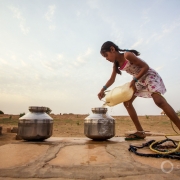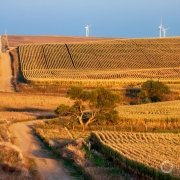What’s Up With Water – February 24, 2020
This is Eileen Wray-McCann for Circle of Blue. And this is What’s Up with Water, your “need-to-know news” of the world’s water, made possible by support from people like you.
Australians are working to rescue their drinking water from the effects of fire, and rain. Many parts of eastern Australia have been drenched by the heaviest rain in decades during recent weeks. The deluge helped to ease severe drought in the state of New South Wales, but it took a toll on some drinking water sources. Residents in the Bega Valley are relying on trucked-in water after the rains inundated a major reservoir with ash and debris from the fierce bushfires last month. The Bega District News reports that trucks are hauling up to a million liters each day at a daily cost of $30,000. The Australian Army set up a mobile water purification station at the reservoir to supplement those deliveries. The mobile station is necessary because water from Bega’s reservoir is not filtered. Owing to the quality of the source, it is only chlorinated. The Guardian reports that the Bega Valley Council wants to install temporary filtration equipment, and it has appealed to the state government for help.
In Sydney, meanwhile, officials said they will relax water restrictions following one of the biggest storm events in the last two decades. Water levels in Sydney’s main dam rose by 20 percentage points in a week. Starting March 1, the city will drop to level one water restrictions. That means residents can wash cars and water their gardens with hoses instead of buckets.
China says it will share some of its water reserves in response to ongoing stress in the Mekong basin. At a meeting in Laos last week, the foreign minister for China said it would release more water from its Mekong River dams to assist downstream neighbors during a severe drought. Reuters News reports that Foreign Minister Wang Yi sought to reassure other diplomats there that China was doing its part in response to low water levels on the key waterway. Independent analysts have pointed to the 11 dams that China has built in the Mekong’s upper reaches, and blamed them for worsening water shortages during a historically dry period in the region. It was not clear when the dam water would be released, or how much would be returned to the river.
In the United States, a federal judge in Texas has thrown out a lawsuit accusing the Army Corps of Engineers of mismanagement. The Texas Tribune reported that that the suit was filed in the wake of Hurricane Harvey, by flooded property owners in Houston who live downstream of two reservoirs that are operated by the U.S. Army Corps of Engineers. The suit alleged that the flooding was caused by the Army Corps’ decision to make “controlled releases” to lessen the pressure of all the water in the dams after Hurricane Harvey’s torrential rains. The judge disagreed, arguing that because of the storm’s record-breaking size, the properties would have flooded regardless of how the dams were operated. Lawyers for the property owners said this ruling contradicts the decision in a case filed earlier by upstream landowners. Both cases highlight the tradeoffs between urban development and water management and the risks of building in close proximity to waterways in an era of stronger storms.
In Louisiana, two state agency reports highlight the economic, social, and environmental risks from groundwater depletion. A report from the Louisiana Legislative Auditor says that Louisiana, though it appears to be water-rich, is using its groundwater unsustainably. The auditor’s office provides policy analysis for state lawmakers. Its report says that falling aquifer levels are threatening drinking water supplies and infrastructure statewide. Overpumping of coastal aquifers allows salt water to creep inland. That is happening in four major aquifers in the state, according to the report, which recommends limits on groundwater pumping. The other report, from the Office of Conservation, has a more narrow focus. It looks at groundwater problems near the state capital of Baton Rouge. The report notes that groundwater levels are falling in the region and salt concentrations are also rising, but the local groundwater agency has no plans to address the crisis. The report advises the Legislature to take action and require the Capital Area Groundwater Conservation Commission to develop a long-term management plan.
This week on Circle of Blue, we report on another supposedly water-rich region where groundwater depletion is forcing local officials to reassess their county’s growth and development.
Paul Sachs is the director of the Ottawa County Planning and Performance Improvement Department.
Sachs’s job is help residents, elected officials, and business leaders look ahead. Though they may live by one of the largest bodies of fresh water on the planet, their fast-growing Michigan county has a water problem. A groundwater problem, that’s more reminiscent of the deserts of the American West than the Great Lakes region.
Sachs and his colleagues have spent years of intensive research in partnership with Michigan State University. He, and others in Ottawa County have gained a solid understanding of the challenge ahead. It’s a dual problem: the county’s deep aquifer is being depleted at the same time that salt concentrations in groundwater are rising. It’s a one-two punch that threatens the county’s residential growth and its diverse farm economy.
Armed with that knowledge, Sachs has become a groundwater evangelist of sorts, aiming to guide Ottawa County’s development toward a more sustainable path, while respecting local decision-making authority. The county is aiming for a delicate balance between protecting its groundwater supply and powering the economic engine that has has propelled the county to the highest population growth in the state.
With those goals in mind, Sachs is coordinating the formation of the state’s first county groundwater commission. The idea is to unite qualified people who will oversee the county’s groundwater sustainability efforts, who will educate local leaders and the public about water-saving practices, and who will evaluate groundwater-protection policies that anticipate population growth. Sachs told Circle of Blue “We hope to direct new growth to more sustainable areas. Previously, without understanding our groundwater, growth occurred wherever developers wanted.”
The balancing act between groundwater use and growth is playing out in state legislatures and county councils across the United States. Groundwater is often unregulated, and is being exploited in many rural areas, either for farming or for residential developments.
In Nevada last December, state officials put a moratorium on new residential wells in a community north of Reno, concerned that too much water was being pumped from the aquifer.
In Arizona, where wells in rural counties are going dry because of high-capacity farm irrigation, lawmakers are considering new groundwater monitoring requirements that would allow them a better understanding of the problem.
Officials in Michigan’s Allendale Township are familiar with dry wells. Allendale is about 15 miles west of Grand Rapids, the state’s second-largest city. Allendale has been a center of growth in Ottawa County. The town of almost 27,000 people has seen its population climb by 30 percent since 2010. Along with growth came water problems. More than a decade ago, long-time residents began to complain about wells going dry. Groundwater levels were found to be declining. Water use for proposed subdivisions attracted greater scrutiny.
Township leaders knew they had to act. In 2018 they placed a six-month moratorium on new housing developments that were not connected to public water and sewer. Public utilities generally draw from Lake Michigan, which is a more abundant source for the county than groundwater. Sachs estimates that a quarter of the county’s residents, mostly in rural areas, use private wells.
Adam Elenbaas is the supervisor for Allendale Township. He said that the moratorium allowed his town to study the issue and enact a long-term policy. The Michigan State study showed that the aquifer in the central part of the county had been drawn down by 35 to 50 feet since the 1970s. Elenbaas told Circle of Blue “We know that we’re pulling water out of the ground faster than it’s being replenished. We don’t want to put more straws into the ground and draw it down even faster.” The Township Board of Trustees approved an ordinance that requires new housing developments to connect to public water. That policy went into effect last April.
Elenbaas said that the groundwater commission, as a facilitator, will be a valuable addition to the county’s sustainability tool box. The county has the resources to bring parties together, but the townships are generally the entities that set land-use rules. The commission, said Elenbaas, will “allow us to see a larger view, instead of our small piece of the puzzle.”
And that’s What’s Up With Water from Circle of Blue, which depends on your support for independent water news and analysis. Please visit circleofblue.org and make a difference through your tax-deductible donation.
Eileen Wray-McCann is a writer, director and narrator who co-founded Circle of Blue. During her 13 years at Interlochen Public Radio, a National Public Radio affiliate in Northern Michigan, Eileen produced and hosted regional and national programming. She’s won Telly Awards for her scriptwriting and documentary work, and her work with Circle of Blue follows many years of independent multimedia journalistic projects and a life-long love of the Great Lakes. She holds a BA and MA radio and television from the University of Detroit. Eileen is currently moonlighting as an audio archivist and enjoys traveling through time via sound.











Leave a Reply
Want to join the discussion?Feel free to contribute!